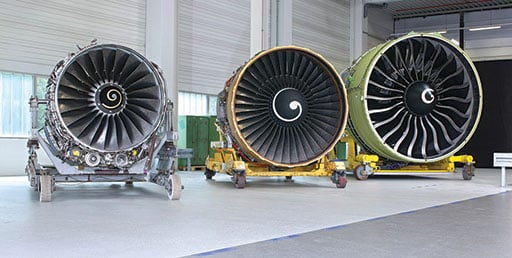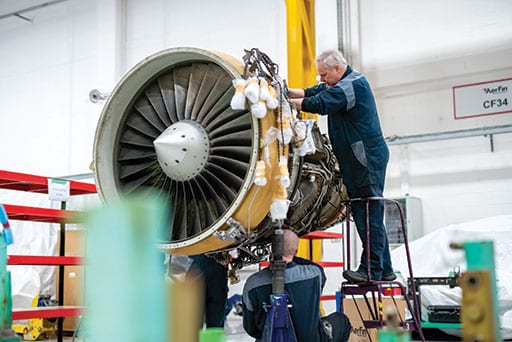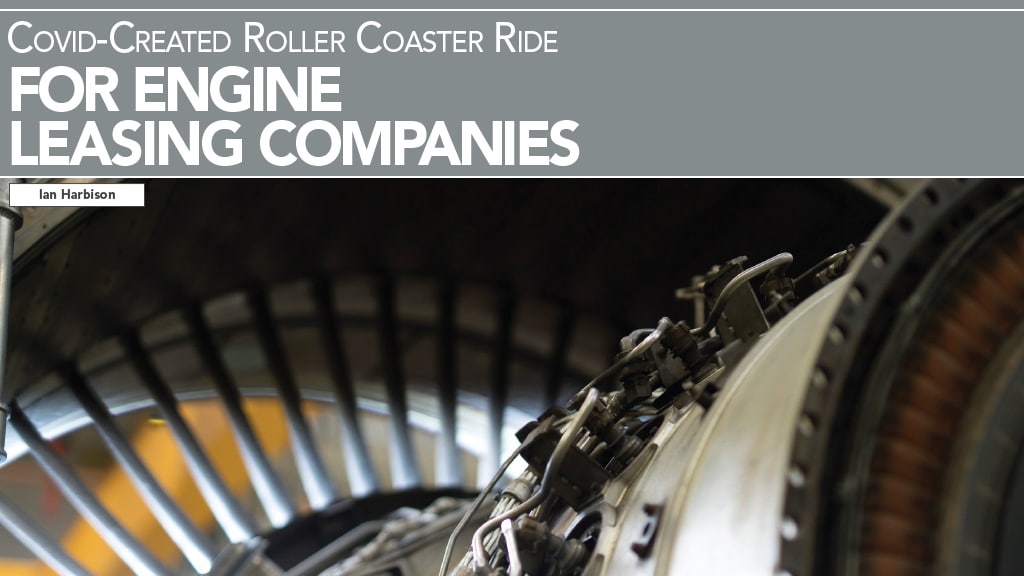Tadhg Dillon, chief commercial officer at Shannon Engine Support (SES), says the company first noticed pandemic activity in China, its biggest market, in mid-January 2020. Within 30 days, airline operations had fallen significantly. By mid-March, the effect was global and airlines entered survival mode and for the first three months, payment deferrals were the main ask from the customers.
For SES, it switched from an office-based to a home-based company within 24 hours, with associated IT and communication challenges to solve in a very short period of time. With no visits possible, all negotiations were carried out online and contracts transferred electronically.
SES had to review its own cash flow situation before it could start any negotiation on medium term solutions with its customers.
At the same time, airlines returned short term lease engines, there were no lease extensions (normally about 25% of leases are extended) and Early Termination Options were exercised. Unfortunately, there were also some bankruptcies, meaning engines had to be repossessed while working remotely. Global Covid restrictions meant there was no access to the customer site, limited resources and transport options, so it was a very difficult time.
As part of their cash conservation program, airlines also removed long term lease engines and installed them on stored aircraft, keeping the rest of the fleet flying with their own powerplants. In that way, while they had to keep paying the lease rental, they could save on the maintenance reserves, although this had a negative cash impact to SES.
The first signs of recovery came from China in June 2020, which meant they were flying when others were grounded. That lasted until early 2021, when another COVID wave hit.
U. S. Makes a Come Back First, Then Europe
He says recovery was based on vaccine distribution, but, given the numbers, it would take a long time, as well as passengers regaining the confidence to fly. The U. S. came back fast, both through mass vaccination and a political will to restart the economy, and its domestic market is now only marginally down from the high levels in 2019.
Of course, the demand was mainly for domestic flights, which played to the company’s strengths, as it specialises in the CFM56 and LEAP series engines, powering the Airbus A320ceo/neo family and Boeing 737NG/MAX.

Shannon Engine Support
Europe came back next and its single aisle fleet is now 90% of 2019 levels. Asia Pacific, Middle East and Africa have been slower, although there is growth. This is still a recovery situation, he says, and one of the main factors is airline profitability, or lack of it. There is demand and, while prices are suppressed versus 2019, they are trending in the right direction.
However, he adds there are two major regions for SES that are proving to be very challenging. Recent figures from China suggest something of a recovery but, while aircraft are flying, the yields for the airlines is unknown. The other is Russia – and, he says, it won’t be back for some time. The company has recovered 20-25% of its engines but there are significant numbers that it has been unable to retrieve.
Taking a broader view, he says that, in 2019, there was massive demand and people were asking when it would peak. From the SES point of view, looking across the aircraft leasing and MRO markets, as well as engine leasing, there were strains on the system. Shop visit (SV) slots were scarce and there were supply chain issues with parts. That reduced the throughput in the shops, which resulted in very high demand for spare engines.
Now, the industry is almost back at the same situation for different reasons. He says a lot of the MROs, airlines and suppliers let go of a huge number of people during the pandemic because of their financial situation. Replacements are difficult to find and are usually much less experienced than the previous staff, as well as increasing turnaround times. Supply chain issues now involve both new parts from OEMs and used serviceable material (USM). There is also a focus on newer generation engines and resolving their technical problems.

He says that, pre-pandemic, the competition was usually other lessors or MROs that might have engines available. That changed as airlines wanted to avoid leasing and maintenance costs, seeing it as negative cash flow. Instead, they would look at alternatives from a financial perspective, such as the need to fly the aircraft and, if they did, the maximum they could pay for an engine, based on passenger demand. They also considered using an engine from another aircraft, using a spare that was on the ground, or leasing an aircraft on a power by the hour basis, Additional competition now came from aircraft lessors with aircraft on the ground, airlines that wanted to lease an engine to another airline and aircraft part out organizations.
It is returning to normal, but the focus is still on cost, each deal being done on a financial basis. He says SES has scale of its operations but also through the provision of customised long-term solutions. This could extend out to 10 years, looking at total demand and developing a structure with the customer that meets all their spare engine needs. It might also cover fleet transitions – A320ceo Family to neo, Boeing 737NG to MAX.
As for the future, interest rates and fuel prices are challenges as they are costs that should be passed on, along with the threat of recession. Perhaps the biggest threat is inflation, as it can have a direct effect on passenger sentiment and associated demand.
Experience Gained
For SES, Dillon credits several factors: the experience gained during the 2009/10 financial crisis; a healthy revenue stream; a resilient and innovative team of people; strong customer relationships; and a global customer presence.
Patrick Biebel, managing director of MTU Maintenance Lease Services, MTU’s Amsterdam-based leasing and asset management arm, says his company specializes in a wide range of narrowbody and widebody engines from the CF34 up to the GE90, primarily focusing on short-term leases (up to two years) to support maintenance events. He agrees that before the pandemic hit, the industry was under strain driven by current generation engines approaching their shop visit peaks and phase-in challenges of new engine equipment. This meant older aircraft were staying in service longer than expected.
When COVID hit, MTU Maintenance Lease Services relied on its established risk management strategy with an engine pool made up of three components: owned engines, long-term lease and short-term lease. This approach allowed for a quick response to the changes in demand driven by the ongoing pandemic situation. At the time, airlines were deferring maintenance and often, when faced with a shop visit that might require a multi-million-dollar investment, would swap engines from their parked fleet or opt for a lease engine, taking advantage of more favorable lease rates.

MTU Maintenance Lease Services
As the drivers of demand are evolving, the industry is facing new obstacles. The MRO supply chain is experiencing capacity shortages, while airlines now need to ramp up their operations quickly, but are faced with staffing shortages, deferred maintenance and a need for lease engines. He says engine lessors are positioned to help smooth out the ramp up – he reckons it may take about two years for the industry to fully recover.
The assets most unlikely to recover from COVID, he adds, are engines related to more niche aircraft, such as the A340 and A380, although these are not leasing markets served by MTU. In addition, earlier CFM56 and V2500 models also saw significant value pressure, especially for teardown assets. During uncertain times, many market players focused their maintenance activities on newer configuration engines with respective effect on used material consumption.
Avoiding Layoffs
In terms of MTU, the company not only avoided layoffs, but also continued with its €500 million ($497 million) investment program into its MRO network to expand capacity at all of its global MRO facilities. Together the company provides holistic approach to support customers with the availability of lease engines and offer alternative solutions to those navigating this COVID recovery period. Furthermore, for lessors and asset owners, MTU Maintenance Lease Services provides a platform to generate value from their under-utilized assets by including them into its lease pool under a managed lease structure, providing a constant revenue stream for the owners. At the end of life, the engine is dismantled and the USM is purchased by MTU to be consumed by one of its over 1,000 shop visit events per year.
Looking at the larger market, he has observed a growing need for aircraft lessors to get more hands on when it comes to engine maintenance activity. Between early returns, customer bankruptcy and deferred or defaulted maintenance reserve payments, the lessors find themselves with engines that are in a good enough condition to be remarketed. This creates a high demand for cost-efficient MRO solutions. He says MTU is ideally placed to help as it offers a wide range of such solutions, including module exchanges, tailored workscopes and green time engine exchanges.
Another sector accelerated by COVID is the P2F market, especially on the narrowbody side, where, he says, conversions are ramping up to more than 80 aircraft/year. Cargo operations typically differ from passenger operations, with many fewer cycles per year, reducing maintenance reserve payments with the respective impact on cash flow. From an investment perspective, often a half-life, high-thrust engine at the right price point is a preferable option. Situations like this are areas where MTU is working closely together with its customers to identify the best possible option, considering all parameters.
Given that airlines in recovery are now faced with rising costs, he says MTU continues to explore options to find cost-effective approaches for its customers. For example, leveraging the modular architecture of the CFM56 by utilizing engine pools to generate modules for exchanges or complete engine build-ups.
He points out that, to run this effectively, sophisticated configuration control is vital, along with understanding the performance implication of each module to ensure LLP limits can be reached.
Narrowbody/Regional Love
Oliver James, VP Commercial Trading at AerFin, says his company is involved in short term engine leasing for both narrowbody and regional aircraft types, predominantly the CF34-8, CFM56 and V2500. The first of these, the CF34-8, performed well through the pandemic, driven mainly by capacity from the U. S. domestic market, and many airlines with CRJ and Embraer series aircraft helped service the localised demand and proved to be an ideal low-cost substitute to fill some of those longer routes, typically served by the larger A320/737 aircraft.
The extended localized lockdowns seen across much of Europe throughout 2021 and into 2022 have meant a delayed recovery of CFM56-5B powered Airbus aircraft due to the higher consolidation of the global fleet being in that region. In contrast, the CFM56-7B, applicable to the 737NG, has seen a quicker recovery, with V2500 followed closely behind. He concurs that the strength of the US domestic market was a great help.
The cargo market has been the lifeline of the aviation industry during the pandemic, historically cargo made up around 12% of the sector’s total revenue; that percentage tripled in 2021 and AerFin expects to continue to see undersupply for some time.
He says the company took a risk managed approach through the pandemic and were selective with how it managed and deployed capital. Most of its focus remained on supporting asset owners through consignment programs, sale and lease back schemes and asset remarketing.

AerFin
For now, he says, AerFin remains well positioned in the market with a healthy volume of equipment in its acquisition pipeline to support the next phase of growth for the business.
Substantial Recovery
Anthony Spaulding, executive vice president at Magellan Aviation Group, says the trading market has made a substantial recovery from the pandemic, with prices starting to rebound, so competition to acquire assets has increased. Magellan specializes in USM and leasing space for the CFM56, V2500, PW4000 and CF34 engine types.

Green time engines are still an important lever for the airlines to manage cash spent on MRO. For example, airlines are finding it difficult to find CFM56-5A engines with green time to defer or replace an engine due for a shop visit, On the other hand, there is an oversupply with the CFM56-5Bs engine type that is depressing lease rates which makes it favorable for airlines when they need a CFM56-5B.

Magellan Aviation Group
Airlines with current technology fleets with an inhouse MRO function are looking at ways to keep the operation running smoothly to avoid SV spend and excessive turnaround times by purchasing engines with a relatively fresh SV. If they can purchase a replacement engine, park or sell the run-out engine, this alleviates unforeseen SV cost escalation and avoids operational disruptions due to excessive turnaround times for engines being repaired.
He comments that, thankfully, the days of an ‘all in’ rate have just about disappeared, that is, airlines only paid a cost per hour when they flew, a trend that started in early 2021 with aircraft lessors, as there was no revenue from parked aircraft. The traditional model of rentals and lease fees has returned, although the rates are a little soft but recovering – a CFM56-7B26 pre-pandemic was $65-70,000/month, it is now $45-50,000+ and climbing, while it is even lower for the CFM56-5B due to the oversupply.
He says the P2F market hasn’t yet helped the -5B rebound like the demand for the CFM56-7B has since there is an approximate 4:1 ratio in favor of the 737-800F over A321F conversions currently. In addition, the A321 also has an engine choice – there is a 70/30 split between IAE and CFM. The SV costs for the V2500 is higher than the CFM56-5B but the V2500 has the advantage of EGT retention. However, he thinks it likely that an A321 freighter will bulk out before it grosses out, which allows operators to derate a bit more and extend engine life.
It may be a similar acquisition strategy for the CFM56-5B powered A321s as happened with the 767 freighter feedstock, where everyone was trying to find CF6-powered aircraft for conversion due to lower SV costs compared to the PW4000. Additionally, as 737/A321 P2F feedstock acquisitions are being made, one of the issues buyers are finding and dealing with is aircraft that were returned during the pandemic tend to have one or more engines that is runout or due for an expensive SV. This is helping bolster values and demand for green time engines, especially for the CFM56-7B.
Labor Shortages Will Play
There is also the issue of extended turnaround times, narrowbody engine overhauls now being similar to those previously for widebody engines. Of course, this is because of labor shortages and supply chain issues, he makes the point that engine piece part repair shops are equally affected, adding that extensive training is required to operate the specialized machinery needed for turbine blades, for example. It also affects Magellan, as spares recovered from tear downs have to be repaired before they can be sold as USM. For the OEMs, he notes raw materials, such as precious metals that are/were sourced from Russia, could also become a problem as demand recovers for new build deliveries.
He too feels that it will take about two years, hopefully less, to recover but this depends on the labor market, as there are general shortages in every area of aviation. One way for the industry to recover from this current situation is to make a concentrated effort to reach out to young people to bring on a new generation that an aviation career will be positive career choice for professional growth with a well-paying salary.
On a more positive note, the spending on maintenance has definitely picked up in the aircraft and engine MRO space that are key customers, which is good news for Magellan and the industry as a whole.
